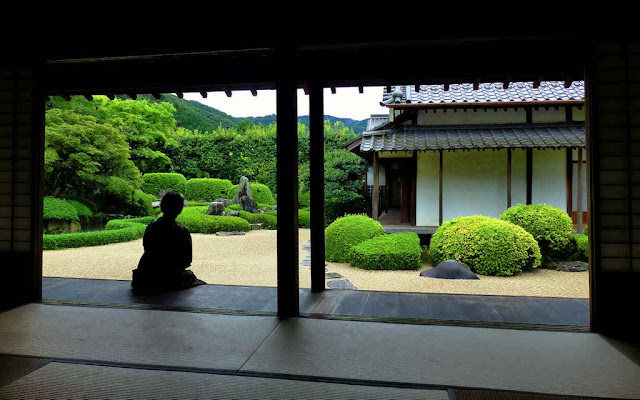Kobori Enshu ( 1579 - 1647 ) was an aristocrat most well known for being a Tea Master.
He was also a painter, poet, and probably the most influential garden designer of the early Edo Period.
His garden at Raikyuji Temple is considered one of his earliest garden designs.
Raikyuji is a Rinzai Zen Temple located in the castle town of Takahashi in Okayama.
The castle,
Bitchu Matsuyama Castle, is one of the 12 castles in Japan still with an original tenshu, or keep, and is also the highest castle in Japan.
Raikyuji Temple's founding date is unknown but it was rebuilt here in 1339 as Ankokuji Temple.
In the early 16th century the temple was developed by the lord of the castle, Ueno Yorihisa. His grave is at the temple.
The temple was destroyed in a battle in 1575 but was rebuilt by the victors.
Following the Battle of Sekigahara, Tokugawa Ieyasu installed Kobori Masatsugu to rule the area.
The castle was still in a state of disrepair after the battle of 1575 so Kobori lived in and administered the area out of Raikyuji Temple.
Following his death in 1604 control passed to his son Kobori Masakazu who would later become known by the name Enshu.
He lived at the temple for 15 years and is believed to have designed the garden during that time.
The garden can be viewed from both the Shoin and building next door.
On the north side of the shoin is a small pond garden to the rear of the main hall.
The garden features heavily-pruned azalea bushes.
Obviously, when they are in bloom in May then the garden takes on quite a different appearance.
the focal point of the garden is a Crane Island with its upright central stone.
Behind it is a Turtle Island, though it is somewhat hidden.
The garden incorporates the "borrowed scenery" of Mount Atago behind it.
A stone lantern dating to 1339 is a focal point of the garden between the two buildings.
In 1974 the garden was registered as National Scenic Beauty Spot.
On this trip I visited Takahashi on Day 6 of my walk along the Chugoku Kannon Pilgrimage. The previous post was on the
photogenic Kiyama Temple.


































